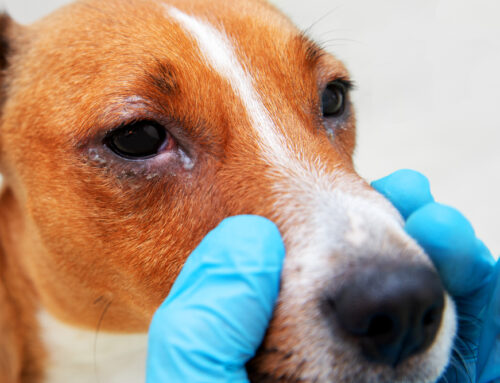If a mysterious lump has appeared near your pet’s eye, you no doubt are concerned. Could the lump be cancer? Is it serious? As pet owners ourselves, we understand your anxiety, and the Veterinary Vision Center team is ready to get to the bottom of your pet’s eye problem. Here are the top five reasons your pet may develop a lump near their eye, and how our team approaches their treatment.
#1: Eyelid tumors in pets
Tumors commonly develop on dogs’ eyelids margins, and occasionally in cats. In dogs, these are usually benign (i.e., non-cancerous) growths, but they can become large rather quickly, rub on the eye surface, and cause irritation, inflammation, or a corneal ulcer. We can remove small growths with cryotherapy (i.e., freezing) or CO₂ laser surgery, and larger growths with traditional surgical techniques. If we deem the growth suspicious, we may recommend removing the lump and submitting tissue to a laboratory for identification.
In cats, eyelid tumors can be caused by a disease that causes multiple, large, fluid-filled cysts (i.e., apocrine hidrocystomas) that have a characteristic appearance. Other eyelid tumors in cats may be cancerous, and some grow aggressively large. We may recommend a biopsy to determine the growth’s cause and identify the best treatment. Treatment for cancerous eyelid tumors requires prompt removal and eyelid reconstruction, if necessary, followed ideally by consultation with a veterinary oncologist.
#2: Blepharitis in pets
Blepharitis is a common and frustrating condition that causes eyelid and oil-producing eyelid gland (i.e., meibomian gland) inflammation, usually in dogs. The inflammation can result in itchy, red, bumpy eyelids, or only one or two red bumps may appear. While anti-inflammatory drops or ointments can help, most pets need oral steroids to quiet the severe inflammation, and may have multiple disease relapses or recurrences. Long-term therapy can reduce the recurrence rate and keep pets comfortable.

#3: Dental or orbital abscess in pets
A swelling under the skin below or beside your pet’s eye could be an abscess (i.e., infection pocket), which can often develop near tooth roots and spread into the sinus cavity or the orbit (i.e., the space behind your pet’s eye). Treatment usually requires oral antibiotics and anti-inflammatory medications, along with a dental exploratory procedure to determine the abscess cause and location. Dental procedures are performed by your primary veterinarian while your pet is anesthetized, and will include X-rays, tooth extraction, if necessary, and a culture to identify the bacteria causing your pet’s abscess.
#4: Cherry eye in pets
Cherry eye is the term used for a prolapsed third eyelid gland, which occurs frequently in young dogs. The gland normally sits tucked underneath the lower eyelid, but when the cartilage that holds this gland in place is weakened or abnormal, the gland can pop out and look like a large, red, lump at the inner eye corner. This gland produces around 30% of your pet’s tears, so surgical repositioning—not removal—is recommended. For young pets, when a gland prolapses on one side, the other side may follow suit, so we often prophylactically tack the other gland in place while performing surgery on the affected eye.
#5: Dacryocystitis in pets
Dacryocystitis is inflammation or infection inside your pet’s tear duct, which commonly occurs in rabbits, and can also occur in dogs and cats. The tear ducts sit along your pet’s eyelid edge, and drain tears down through the facial bones into the nasal cavity—tear ducts are the reason your nose runs when your eyes are irritated. If the gland becomes obstructed, infection can take hold, and a swelling could develop at or below your pet’s inner eye corner.
Dacryocystitis treatment often involves oral medications to resolve the infection, and attempts to flush the tear ducts. Rabbits often require dental work, as their constantly growing teeth are usually the problem. Surgery is rarely recommended, but can sometimes be used to re-route the duct or remove an obstruction in pets with chronic or recurrent problems.
A new lump or bump on or near your pet’s eye should be promptly examined by your primary veterinarian, or by our Veterinary Vision Center team. Many eye conditions are beyond the scope of your primary veterinarian, but our hospital is well-equipped to diagnose and treat any advanced eye issue and get your pet back to feeling like themselves. Contact us to schedule a visit, or if you have any questions about your pet’s eye condition.







Leave A Comment